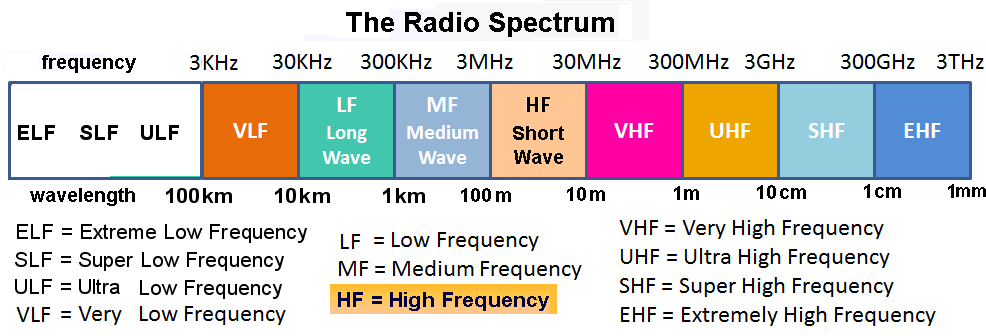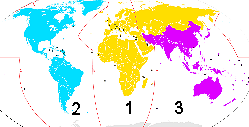 HF bands allocated for radio amateurs and their features
HF bands allocated for radio amateurs and their features
What are Ham Radio Frequency Bands?
Radio amateurs have access to HF bands ranging from 3 to 30 MHz, which allows them to communicate across large distances. They can be classified into three categories: lower bands (80 m, 40 m) for nighttime and winter use, mid-range (20 m, 17 m, 15 m) for optimal daytime DXing, and higher bands (12 m, 10 m), which vary with solar activity. Each band has unique features designed for various propagation conditions and transmission modes, including CW, voice, and data. Depending on the conditions, certain bands are better at specific times of day.
See the official ham band plans, tables and charts.

Figure 1: The radio spectrum is divided into 12 bands, each spanning an order of magnitude.
The following is a list of frequency allocations in the HF band for radio amateurs in various countries around the world.
- The 160-meter band, ranging from 1.8 to 2.0 MHz, is technically situated just below the HF range rather than being classified as an MF band. It enables daytime ground wave communication over distances of up to 150 kilometers. During winter evenings, nighttime communication becomes feasible through F-region skip propagation. To consistently enhance signal-to-noise ratio, a magnetic loop receiving antenna is essential.
- Moving up, the 80-meter band (3.5–3.8 MHz Region 1; 3.5–3.9 MHz Region 3; 3.5–4.0 MHz Region 2) is the lowest HF band. Like 160m it suffers a daytime D-region absorption. During winter nights signals can propagate halfway around the world via F-region.
- The 60-meter band (5.3305–5.3665 MHz) is unique, allowing regional communication on a secondary basis with special licensing, limited power, and restricted modes and frequencies.
- At the 40-meter band (7.0-7.2 MHz in Regions 1&3, up to 7.3 MHz in Region 2) is a popular amateur band due to its clear skip zone during the day, less severe D-region absorption, and reliable worldwide communication via F-region during night. Even during low solar activity this band may be open for worldwide DX throughout the night.
- The 30-meter band (10.100-10.150 MHz) is a unique communication band that allows daytime communication up to 3000 km and nighttime communication halfway around the world. It operates 24/7 via F-region with minimal variation over the 11-year solar cycle. This band is contest-free and exclusively used for CW and narrowband digital modes.
- The 20-meter band (14.000-14.350 MHz) is a popular choice for international communication, renowned for its daylight reliability. It can stay open during solar maximum periods, with skip distance and E-region propagation detected along short paths.
- The 17-meter band, (18.068-18.168 MHz) similar to the 20-m band, is affected by fluctuating solar activity. High solar activity ensures reliable daytime and early-evening long-range communication, while moderate years may only open during sunlight hours. At solar minimum, 17 m will open to middle and equatorial latitudes, but only for short periods during mid day on north - south transequatorial paths.
- The 15-meter band (21.000-21.450 MHz) is a prime DX Band during peak years, but is sensitive to changing activity, closing after sunset. During solar minimum the band is closed except for infrequent north-south transequatorial circuits. Sporadic E is occasionally observed in early summer and mid-winter, but not as common.
- The 12-meter band (24.890-24.990 MHz) combines 10 and 15 m bands charactaristics, may stay open after sunset during solar maximums. Moderate solar activity opens to low and middle latitudes during daytime hours, with occasional daytime openings in low latitudes, over north-south transequatorial paths. The main sporadic-E season from late spring through summer and short openings may be observed in mid-winter.
- The 10-meter band (28.000-29.700 MHz) is known for its extreme variations in propagation modes and characteristics. During solar maxima, it is efficient for long-distance F2 propagation, with DX abundant with modest equipment. During moderate solar activity, it opens only to low and transequatorial latitudes around noon. This band shares propagation modes with VHF, such as meteor scatter, aurora, auroral E, and Transequatorial spread-F. Techniques similar to VHF can be effective on 10 meters.
| Lower frequency bands (160–40 m) are susceptible to fadeouts and blackouts, while higher HF bands (30–10 m) often become active during daylight hours, offering improved global coverage. |
| The higher HF bands (from 17 to 10 meters) are more reliant on sunspots and solar flux. |
Choose the right band and plan your operating time
To maximize success in ham radio QSOs, match your band choice and operating time to propagation conditions: Low-frequency bands (160 m, 80 m, 40 m) perform best at night and during winter; mid-range bands (20 m, 17 m, 15 m) are ideal for daytime long-distance DXing; and high bands (12 m, 10 m, 6 m) depend heavily on solar activity and sporadic-E propagation. Timing is crucial—greyline propagation during sunrise and sunset can significantly enhance long-distance communication.
References:
- Nomenclature of the frequency and wavelength bands used in telecommunications (2022) ITU Radiocommunication Bureau
- International Telecommunication Union Wikipedia
- ITU Homepage ITU
- International Amateur Radio Union Wikipedia
- ITU region map Wikipedia

- IARU Region 1 Band Plan, June 2001
- IARU Region 2 Band Plan, September 2020
- IARU Region 3 Band Plan, September 2019
- Amateur radio frequency allocations Wikipedia
- 160-meter band Wikipedia
- 80-meter band Wikipedia
- 60-meter band Wikipedia
- 60 metre band HFLINK
- Ham Radio 101: What is the 60 Meter Band? On All Bands
- 40-meter band Wikipedia
- 30-meter band Wikipedia
- 20-meter band Wikipedia
- 17-meter band Wikipedia
- 15-meter band Wikipedia
- 12-meter band Wikipedia
- 10-meter band Wikipedia
- 8-meter band Wikipedia
- 6-meter band Wikipedia
- Amateur Radio Band Characteristics Ham Universe, Don Butler, N4UJW
- The MF and HF bands assigned to radio amateurs 4X4XM
- List of amateur radio modes Wikipedia
- Analog transmission Wikipedia
- Analog to digital converter Wikipedia
- Data communication Wikipedia
- Digital to analog converter Wikipedia
- Modulation Wikipedia
- Radio Wikipedia
- Signal transmission Wikipedia
- Frequencies for digital modes PA8S
- What is FT8? Wikipedia
- FT8 Main Frequencies:
- 160m – 1.840 MHz
- 80m – 3.573 MHz
- 40m – 7.074 MHz
- 60m – 5.357 MHz
- 30m – 10.136 MHz
- 20m – 14.074 MHz
- 17m – 18.100 MHz
- 15m – 21.074 MHz
- 12m – 24.915 MHz
- 10m – 28.074 MHz
- 6m – 50.313 MHz
- 2m –144.174 MHz
International Telecommunication Union (ITU)
Telecommunications Regions
Official ham band plans, tables and charts
Supplemental information about bands assigned for radio amateurs
Communication Modes and Techniques
Signal Processing and Communication
Digital modes with an emphasize on FT8—a popular form of digital weak signal communication